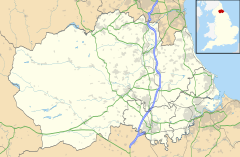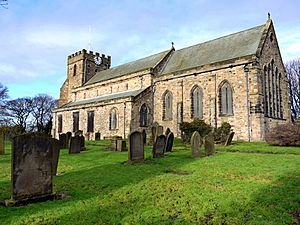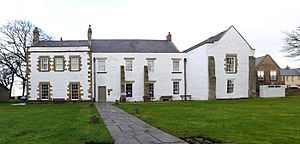Easington, County Durham facts for kids
Quick facts for kids Easington
|
|
|---|---|
| Village and civil parish | |
 The village green |
|
| Population | 2,171 |
| OS grid reference | NZ415432 |
| Civil parish |
|
| Unitary authority |
|
| Ceremonial county | |
| Region | |
| Country | England |
| Sovereign state | United Kingdom |
| Post town | PETERLEE |
| Postcode district | SR8 |
| Dialling code | 0191 |
| Police | Durham |
| Fire | County Durham and Darlington |
| Ambulance | North East |
| EU Parliament | North East England |
| UK Parliament |
|
Easington, also known as Easington Village, is a small village in eastern County Durham, England. It is located where the A182 and B1283 roads meet. These roads connect it to Hetton-le-Hole in the north-west and Horden in the south-east.
The village is also close to the A19. This major road goes north towards Seaham and Sunderland. To the south, it leads to Peterlee and Stockton-on-Tees. In 2011, about 2,171 people lived in Easington Village.
Contents
Exploring Easington's Past
Easington has a very long history. People have found old building pieces from as early as the 8th century. These pieces were discovered inside St Mary's Church. The church itself was mostly built in the 12th and 13th centuries. It also has some interesting wooden carvings from the 1600s. For many years, from 1256 to 1832, the main priest of Easington was also an important church leader in Durham.
One famous event in the village's history happened on the village green. Two men were punished there for being part of a plan. This plan aimed to replace Queen Elizabeth I with Mary, Queen of Scots. An important person named Pope Adrian IV once lived here. He was born Nicholas Breakspear around 1100. The village is also known for a local story called "The Legend of the Easington Hare."
Easington is home to Seaton Holme, a very old house. It is one of the few 13th-century homes still standing in the country. This building was once a home for church leaders. Later, it became a rectory until about 1960. For a while, it was even a children's home. After some time, it started to fall apart. But in 1992, it was carefully fixed up and restored.
How Coal Mining Changed Easington
Big changes came to Easington when people started digging for coal nearby. The first coal mine began on April 11, 1899. A new town, Easington Colliery, grew up around this mine. Over time, the two settlements along the B1283 road grew closer. Eventually, they almost merged into one larger area.
However, Easington Village and Easington Colliery still have their own unique feel. They show different parts of history. The Easington Colliery mine was the last coal mine to close in the Durham Coalfields. This happened in 1993. When it closed, about 1,400 jobs were lost.
Village Life and Education
Easington has local services for its residents. There used to be several post offices. One of them closed in 2008.
Easington Academy is located in the village. This school is the main secondary school for students from Easington and the nearby areas. It provides education for young people in the community.
Famous Faces from Easington
Many talented people have come from Easington. Here are a few:
- Matt Baker – a well-known television presenter. You might know him from shows like Blue Peter and Countryfile.
- Dennis Donnini – a brave person who received the Victoria Cross, a very high award for courage.
- Steve Harper – a famous goalkeeper who played for Newcastle United.
- Rachel Howard – a talented artist.
- Jez Lowe – a popular folksinger and songwriter.
- Kevin Scott – another footballer who played for Newcastle United.
- Tom Simpson – a champion cyclist.
- Adam Johnson – a footballer who played for Sunderland.
- Alan Tate – a footballer who played for Swansea City.
- James Isaacson – a rugby player for Newcastle Falcons.
- Ian Cranson – a footballer who played for Ipswich, Sheffield Wednesday, and Stoke City.




